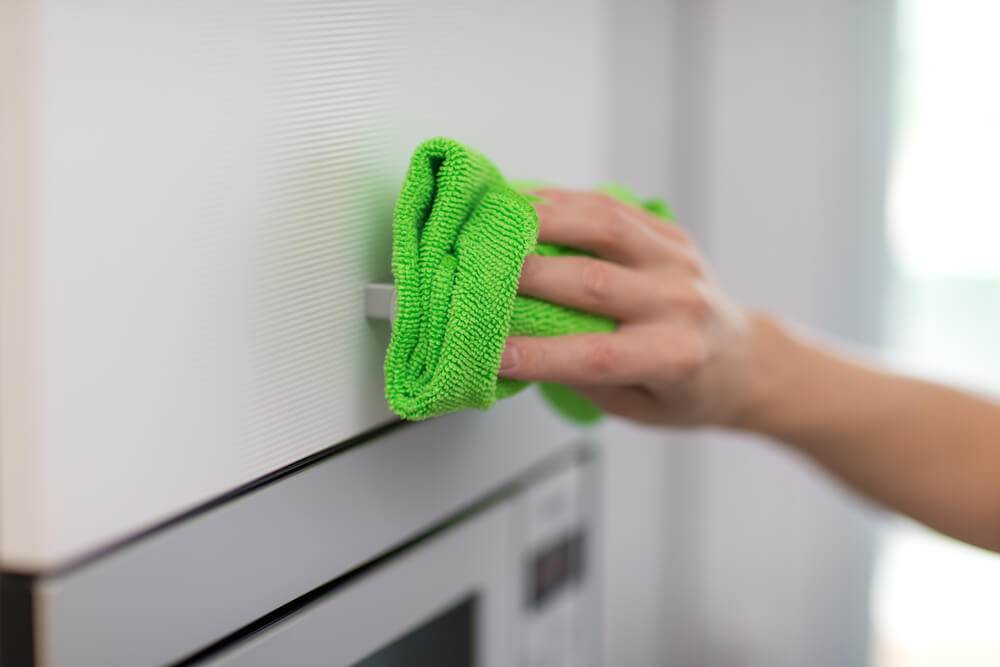
Dusting is a household chore that can be easily overlooked but is essential in maintaining cleanliness and hygiene in your home. While most people assume that dusting is a straightforward task that only requires a cloth and some elbow grease, there is an ongoing debate about whether you should use a wet or dry cloth for the job.
Some people argue that using a dry cloth is more effective, while others prefer using a wet cloth for a more thorough clean. So, should you dust with a wet or dry cloth?
In this article, we’ll explore the pros and cons of each method, as well as provide tips on when to use a wet or dry cloth based on the situation. By the end of this article, you’ll have a better understanding of which method works best for your dusting needs.
Should You Dust With A Wet Or Dry Cloth?
You should dust with a wet or dry cloth depends on several factors, including the type of surface you are dusting, the amount of dust buildup, and your personal preference. Both wet and dry cloths have their advantages and disadvantages.
Using a dry cloth is a quick and easy way to remove light dust from surfaces. Dry cloths are more effective at preventing streaking on surfaces and are great for regular maintenance or touch-ups. However, dry cloths may not pick up all dust particles, and in some cases, they can spread dust around, making the dusting process less effective. Also, dry cloths may scratch certain surfaces, especially delicate ones.
Using a wet cloth can be more effective for deep cleaning and removing heavy dust buildup. Wet cloths pick up more dust particles and can clean surfaces more thoroughly. Wet cloths are also more eco-friendly than disposable dry cloths. However, using a wet cloth requires more time and effort, and it can leave streaks on surfaces. Additionally, wet cloths can damage certain surfaces, such as wood or electronics.
In general, using a dry cloth is suitable for regular maintenance and light dusting, while a wet cloth is more appropriate for deep cleaning and heavy dust buildup. However, it’s essential to consider the type of surface you’re cleaning and the amount of dust buildup before deciding on which cloth to use. Additionally, it’s crucial to use the appropriate cleaning solution when using a wet cloth to avoid damaging surfaces.
Ultimately, the choice between using a wet or dry cloth depends on your cleaning needs and preferences. Some people may prefer to use a dry cloth for all their dusting needs, while others may prefer to use a wet cloth for a more thorough cleaning. It’s important to experiment with both methods to determine which one works best for you.
Pros And Cons Of Dusting With A Dry Cloth
Advantages And Disadvantages Of Using A Dry
Using a dry cloth for dusting is a popular cleaning method that many people prefer due to its convenience and ease of use. However, it also has its advantages and disadvantages, which we’ll explore below.
Advantages:
- Quick and easy: Using a dry cloth is a quick and easy way to remove light dust from surfaces. It’s ideal for regular maintenance or touch-ups and can be done in a matter of minutes.
- Prevents streaking: Dry cloths are more effective at preventing streaking on surfaces. Unlike wet cloths, which can leave streaks if not used correctly, dry cloths can be used on most surfaces without leaving any marks.
- Cost-effective: Dry cloths are generally more cost-effective than wet cloths, especially if you use reusable microfiber cloths instead of disposable ones.
Disadvantages:
- Not as effective: Dry cloths may not pick up all dust particles, and in some cases, they can spread dust around, making the dusting process less effective.
- Can scratch surfaces: Dry cloths may scratch certain surfaces, especially delicate ones such as glass or polished surfaces. This is because the dust particles on the cloth can act as abrasives, scratching the surface when rubbed.
- May require more effort: For heavy dust buildup, using a dry cloth may require more effort and time to clean the surface thoroughly.
Overall, using a dry cloth for dusting has its advantages and disadvantages. It’s quick and easy, prevents streaking, and is cost-effective. However, it may not be as effective in removing all dust particles, can scratch certain surfaces, and may require more effort for heavy dust buildup. It’s important to consider these factors before deciding whether to use a dry cloth for dusting.
Pros And Cons Of Dusting With A Wet Cloth
Advantages And Disadvantages Of Using A Wet Cloth
Using a wet cloth for dusting is another popular cleaning method that many people prefer, especially for deep cleaning and heavy dust buildup. However, it also has its advantages and disadvantages, which we’ll explore below.
Advantages:
- More effective: Wet cloths are more effective at removing dust particles, especially for heavy dust buildup. The dampness helps to trap the dust, preventing it from spreading around.
- Deep cleaning: Using a wet cloth for dusting can provide a deeper clean, especially when combined with a cleaning solution. This can help remove dirt and grime that may have accumulated on the surface.
- Eco-friendly: Wet cloths are more eco-friendly than disposable dry cloths, as they can be washed and reused multiple times.
Disadvantages:
- Requires more time and effort: Using a wet cloth for dusting may require more time and effort, as you need to wet the cloth, wring it out, and then wipe the surface. Additionally, you may need to rinse the cloth several times to avoid spreading dirt and grime around.
- May leave streaks: If not used correctly, a wet cloth can leave streaks on surfaces, especially on glass or polished surfaces. This is because the water droplets can leave marks as they dry.
- Can damage certain surfaces: Wet cloths may not be suitable for all surfaces, as they can damage certain materials such as wood or electronics. Using too much water can also cause water damage to some surfaces.
Overall, using a wet cloth for dusting has its advantages and disadvantages. It’s more effective for deep cleaning, eco-friendly, and can provide a thorough clean. However, it may require more time and effort, may leave streaks, and can damage certain surfaces. It’s important to consider these factors before deciding whether to use a wet cloth for dusting, and to use the appropriate cleaning solution and method for each surface.
When To Use A Dry Cloth?
Knowing when to use a dry cloth for dusting can help make your cleaning process more effective and efficient. Here are some situations where using a dry cloth is ideal:
- Regular maintenance: If you’re doing regular maintenance cleaning, such as wiping down surfaces to remove light dust, a dry cloth is an excellent choice. It’s quick and easy to use, and you can cover a large area in a short amount of time.
- Delicate surfaces: Dry cloths are ideal for delicate surfaces such as glass, mirrors, and polished surfaces. These surfaces can scratch easily, so using a dry cloth helps prevent damage.
- Quick touch-ups: If you need to do a quick touch-up to a surface, such as removing a fingerprint or smudge, a dry cloth is ideal. It’s easy to use and won’t leave any streaks or marks on the surface.
- Cost-effective: If you’re looking for a cost-effective cleaning method, using a dry cloth is an excellent option. You can use reusable microfiber cloths that can be washed and reused multiple times, which can save you money in the long run.
- Allergies: If you or someone in your household has allergies, using a dry cloth can help reduce the amount of dust in the air. Wet cloths can create more moisture in the air, which can exacerbate allergies.
Overall, using a dry cloth is ideal for regular maintenance cleaning, delicate surfaces, quick touch-ups, cost-effectiveness, and allergies. Knowing when to use a dry cloth can help make your cleaning process more efficient and effective.
When To Use A Wet Cloth?
Using a wet cloth for cleaning can be highly effective in certain situations. Here are some instances where using a wet cloth is ideal:
- Heavy dust buildup: If you have heavy dust buildup on surfaces, using a wet cloth is a great way to clean it effectively. The dampness of the cloth helps trap the dust particles, preventing them from spreading around.
- Sticky and greasy surfaces: Wet cloths are ideal for cleaning sticky or greasy surfaces, such as kitchen counters or stove tops. The moisture from the cloth can help break down and remove the grime and dirt.
- Bathroom surfaces: Wet cloths are excellent for cleaning bathroom surfaces, such as sinks, toilets, and shower stalls. These areas tend to have more bacteria and germs, and using a wet cloth with a cleaning solution can help sanitize and disinfect them.
- Outdoor cleaning: If you’re cleaning outdoor surfaces, such as patio furniture or decks, a wet cloth can be highly effective. It can help remove dirt and grime that may have accumulated on these surfaces.
- Deep cleaning: If you’re doing a deep cleaning of your home, using a wet cloth can help provide a more thorough cleaning. It can help remove dirt and grime that may have built up over time, especially when combined with a cleaning solution.
Overall, using a wet cloth is ideal for heavy dust buildup, sticky and greasy surfaces, bathroom surfaces, outdoor cleaning, and deep cleaning. It’s important to use the appropriate cleaning solution and method for each surface, and to be mindful of surfaces that may be damaged by water.
Conclusion
After exploring the advantages and disadvantages of using wet or dry cloths for dusting, it’s clear that there is no definitive answer to the question of which one is better. Both wet and dry cloths have their benefits and limitations, and the choice ultimately depends on the type of surface being cleaned and the amount of dust buildup.
For regular maintenance and light dusting, a dry cloth is a quick and easy option that can prevent streaking on surfaces. Dry cloths are ideal for delicate surfaces, such as glass and mirrors, as they are less likely to scratch them. However, dry cloths may not pick up all dust particles, and they can spread dust around, making the dusting process less effective. Also, when used incorrectly, dry cloths can scratch surfaces.
On the other hand, using a wet cloth can be more effective for deep cleaning and removing heavy dust buildup. Wet cloths pick up more dust particles and can clean surfaces more thoroughly. They are also more eco-friendly than disposable dry cloths. However, using a wet cloth requires more time and effort, and it can leave streaks on surfaces if not used correctly. Additionally, wet cloths can damage certain surfaces, such as wood or electronics.
When deciding whether to use a wet or dry cloth, it’s crucial to consider the type of surface being cleaned and the amount of dust buildup. For delicate surfaces, a dry cloth may be a better option, while a wet cloth may be more appropriate for deep cleaning and heavy dust buildup. It’s also essential to use the appropriate cleaning solution when using a wet cloth to avoid damaging surfaces.



